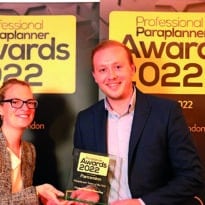The paraplanning team at Hampshire-based Chartered Financial Planning firm Chadney Bulgin, combines two ways of working, offering the firm’s advisers the option of one-to-one paraplanning support or a pooled service.
This is a team of eight. Martin Green, the paraplanning manager, heads up the unit, and there are six female paraplanners, including the deputy paraplanning manager, Charlotte Walker. Two paraplanners work for one or two advisers, one works for an adviser and as part of the pool, while the others form the pooled unit.
They are ably supported by a dedicated paraplanning assistant.
The pool serves 13 different advisers. Martin Green describes the operation as an insourced unit, “effectively an outsourced paraplanning unit working within the business”. The advisers pay for the service themselves and so choose which option they need to meet their requirements – a dedicated paraplanner or the pooled arrangement where they are charged on a ‘time spent’ basis.
For their part, the paraplanners say the system allows them to work in the way that best suits them. As an example, Roxanne Jarvis recently moved from working for one adviser to the pooled unit. She explains the reason for her switch: “I liked working with one adviser, it was nice to build a rapport with one person and to have that familiarity and to specialise in the work that they do. But in the pool there is greater diversification, you get to know how different people work and it allows me to get stuck in a bit more, as you never know what you might be working on day-to-day. I chose to move to get that variety.”
The downside to the pooled way of working, the team acknowledges, is that with the ratio of advisers to paraplanners there is not the opportunity to get to know the advisers as well, nor the individual clients. To the question whether, with this set up, the unit can have a true team culture, almost as one they jump in with an affirmation. “We definitely are a paraplanning team. If one of us needs help, whether they are working for one adviser or in the pool, we all pull together. We all sit together as a group, which means we share thoughts and if someone needs to know something we help out. We’ll bat ideas around. We’re quite vocal,” they say. “
The paraplanning assistant packages the cases, prints the necessary documents, makes client appointments and does everything that needs doing outside of the actual paraplanning. “We wouldn’t be able to do the job without her,” Green says.
Work allocation
Work is allocated as it comes in, by date order. “There’s no cherry-picking of work. Everyone just gets stuck in, according to their level of training; not all of us would be able to take on a DB transfer case for instance,” Charlotte Walker says.
“Where we do get to choose a bit more is if a number of jobs all come in at the same time. Also, if you’re starting something late in the day it’s often best to take a piece of work that you know can be turned around quickly rather than start on a big case, for example.”
“And if one of us gets a really difficult case,” the others chime in, “we’ll say they took one for the team, because there are some bad ones out there!”
In order to maintain a high and consistent level of knowledge they will look to ensure everyone keeps their hand in with the various types of cases. They cite a recent influx of bond surrenders as an example.
Most of the cases were for a paraplanner working solely for one adviser. They swapped out surrender cases for pooled cases for a staff member who had yet to undertake bond surrenders, so she could learn the process.
That is part of the team ethos. “By sharing work out everyone gets to learn everything, which means in theory anyone can pick up a case and work on it. With a high level of skill across the board if someone is away then you are not dependent on one person to know how to handle a case.”
Workflow
The team uses Adviser Office from IRESS to monitor and control the workflow. “When case comes in we’ll log it into the software and use the diary system to take the next case due to be worked on; that works for cases for one adviser or those from across the rest of the advisers in the pool.” Each case has a 10-day turnaround allocated.
The team’s deputy paraplanning manager, Charlotte Walker, created a system which ensures every piece of work is logged and can be monitored in terms of its progress, so that if anyone else needs to pick up the case along the way, they know exactly where it is in the process and what needs to be done.
The set up of the operation means paraplanners do not attend client meetings with the advisers and only Sue Derbyshire, who works solely for one particular adviser, has any client contact at all. “I have a lot of contact because the adviser is so busy and needs me to talk to clients while he is out and about,” she explains.
Accordingly, in order to get sufficient information to produce a report, the paraplanning team has put in place a subscribed format, which sets out the amount of information and documentation it requires from any adviser about a case before a member of the team will pick it up to deal with it. If that level of information is not present the case goes back to the adviser to be updated.
Templates
The adviser to paraplanner ratio and the volume of work coming in mean that the team has had to work on making the process as slick and efficient as possible.
Use of report templates is a major part of those efficiencies. “Templates speed up the paraplanning process so the client receives the report quicker, and they ensure all the relevant bases are covered.
As well as making us more efficient we are reducing risks for the business by abiding by all the rules we need to when writing the reports,” they say.
The team uses templates for the different areas of advice, which include “standard paragraphs that can’t come out for compliance reasons”. But other than those areas, report writing is “pretty much freestyle”, they say. “As long as we keep in those prescribed elements we can put in what we feel will help the client to understand the advice.
“At the same time, while we are freestyle, it’s nice to have that format there to know we are consistent in what we produce.”
Admin to paraplanning
One of the striking elements of this team is that every one of them has come through the ranks, from the administration unit of the business, or a similar admin role outside of the firm, to the paraplanning unit. They recommend it as a way for people to become paraplanners. “If you’re coming from inside the business then you know the way the business works, the people and what paraplanners need to do their job. That makes for an easier transition into the role.”
But there are still challenges, they admit. “In admin you have to be really organised, as you’re working through a series of quick processes, helped by tick sheets. When you first come up from admin to paraplanning and you’ve never written anything like a report or a letter, it can be daunting.”
Storytelling, to help the client understand the advice being given, is the main challenge in moving from admin to the paraplanning team, they say. “It’s just a completely different skill set.
“And it doesn’t help that we might get bullet points of seemingly random facts from the adviser that we need to make sense of and build into a story that the client will respond to. Story writing is a skill which is more difficult than you imagine.
When you start off in the role you can be mentally exhausted – you’re concentrating all day. You could be working on one case for hours compared to a number of quick, 10 minute tasks in admin. At the same time you’re developing your writing skills and building your technical knowledge.”
The second challenge, they say, is having the confidence to speak to advisers about technical issues, discussing cases and being prepared to be challenged on some points.
“There’s a difference in the way you’ll talk to advisers and you have to learn how to approach people and talk to them to get what you want from different personalities.
“When you’re in admin you see the letters but you don’t know how the paraplanner and the adviser got to that final letter. It’s a completely different role and there can be a steep learning curve.”
“When I first started my reports and letters came back with corrections all over them – that was disheartening. But it was a process of learning how to communicate what we need to in the way that we need to and I write so much better now because of it,” Roxanne Jarvis says.
Adviser paraplanner relationship
When asked what they feel they provide for advisers, trust comes out top of the list. “We give advisers trust and the peace of mind that the team behind them know what they are doing and can give quality information to pass on to the client – and that the client isn’t going to have to wait too long to get the information. We’re also a sounding board and back-up to ensure they haven’t forgotten anything.”
The paraplanners working for one or two advisers say it’s a two-way relationship with each of them learning the other’s ways and how they will respond to different things. Those working in the pool say: “You can’t approach everyone in the same way, there’s a learning process where you get to know their personalities and that helps you to understand and approach them in the right way.”
Where any issues arise or if a team member is unsure of an approach, the team provides collective support. “We’ll ask each other’s opinion on an idea, so when we go to see the adviser with a difficult issue, for example, we’re sure of our facts and we’ve got the thinking of the team behind us.”
With many of the team and the advisers having worked for the company for a number of years Green says that, in general, “we’ve got to know each other so we rarely get issues and when we do they will often be resolved quite quickly.”
Core team elements
If there are two core elements that contribute to the team culture at Chadney Bulgin it is having the right people in the right job and communication, says Green.
“It is very difficult to recruit people that all have the right personality and the right attitude. To have a good paraplanning service means having a great team who all get on with one another, so they gel and you get that willingness to help one another do the best job for the client.”
It’s also recognising that from time to time people need a change – hence the move mentioned earlier.
Communication “and the willingness to help each other in a non-judgemental way” also ensure people get on and the whole team works as one, Green says.
The team backs him up: “We’re all good at speaking up and we’re not afraid to ask about something if we don’t know it. There’s no question that is stupid. We’re not frightened of saying something wrong and being corrected.”
Keeping abreast of change
The team ethos extends to training and exams too. “We have a range of ways we keep up-to-date with everything that is happening in the market. We have in-house training as well as from external companies; we hold regular paraplanning meetings where we share knowledge and ideas; we read magazines; and we’re constantly asking questions and sharing things all the time.
“Having the workflow system we use means we get a diverse range of cases to deal with which means we are always learning.
“And because we are a tight team, sitting together, if someone asks a question everyone hears and can learn from it. And everyone gets involved with updating the factsheets when new legislation comes in.
The team also studies together when sitting exams, which they see as being essential to their role. “With the advisers being so busy, it’s down to us to have the up-to-date knowledge so that it can be applied to give the client the best outcome.”





























